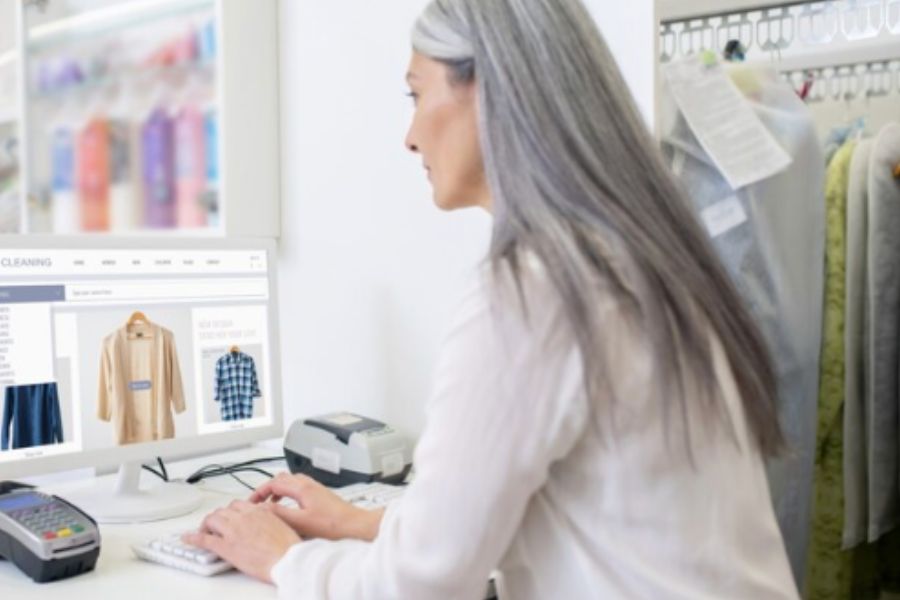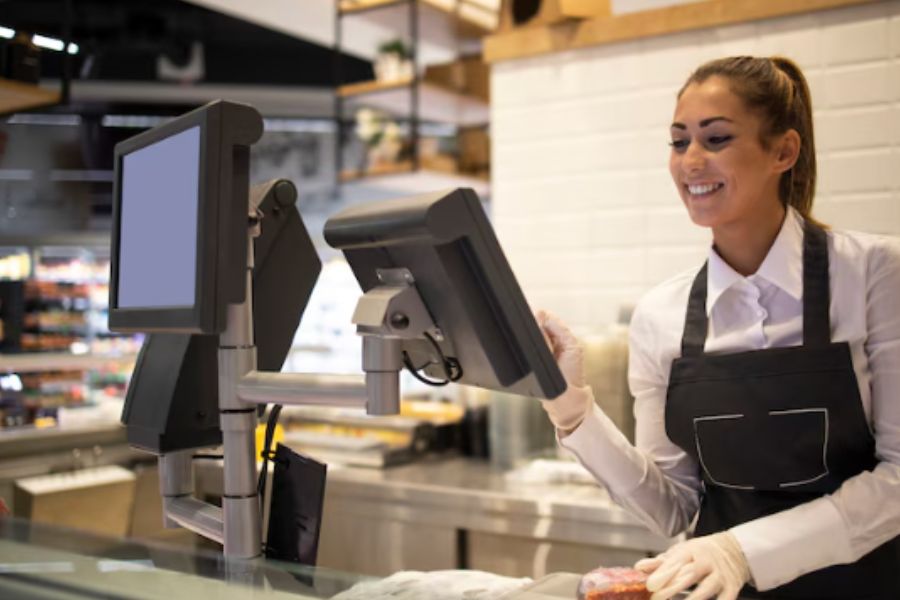In the dynamic landscape of the European apparel industry, the adoption of cutting-edge Point of Sale (POS) software is shaping the way businesses operate. From innovative features catering to customer preferences to seamless integrations with inventory and e-commerce platforms, the latest trends in POS software for apparel are revolutionizing the retail experience.
Overview Of The Apparel Retail Industry In Europe
Europe stands as the headquarters for some of the globe’s most prominent apparel companies, boasting a thriving apparel sector. As per the 2022 World Trade Statistical Review by the World Trade Organization, the European Union (EU) emerges as the world’s primary importer of apparel and textiles.
In 2021, the EU, with a population of 447 million in 2022, commanded a staggering 34.1% share of the global apparel and textile imports in terms of value. In contrast, the USA, the second-largest importer with a population of 333 million in 2022, lagged significantly at 18.5%.
The EU leads in importing goods from developing nations, closely followed by the Americas. Notably, the EU witnessed a nearly 2.5% increase in exports from developing countries between 2017 and 2022.
In 2022, Europe’s apparel imports amounted to €191.4 billion, a notable rise from €138 billion in 2017, equivalent to 32.2 billion units of clothing, up from 27.8 billion. The market demonstrated consistent growth, averaging 6.75% annually between 2017 and 2022. Despite facing pandemic-related challenges, 2022 marked an impressive 27% year-on-year growth.

McKinsey’s State of Fashion 2023 report anticipates a global sales growth range of 5% to 10% for luxury and a more varied negative 2% to positive 3% for the broader industry in 2023. The European outlook, however, is tempered by inflation and high interest rates linked to the energy and cost of living crises, exacerbated by the conflict in Ukraine. McKinsey predicts a range of negative 4% to positive 1% growth for non-luxury and 3% to 8% growth for luxury in Europe during 2023.
Despite challenges, the EU’s economic performance exceeded expectations toward the end of 2022. Consequently, the European Commission revised its GDP growth forecasts for 2023 and 2024 in May 2023, upgrading them from 0.8% and 1.6% to 1% and 1.7%, respectively. This positive shift was primarily attributed to lower energy prices and alleviation of supply chain issues.
Latest Trend Of POS Software For Apparel In Europe
Wireless POS Systems
The advent of wireless POS systems marks a substantial leap in the apparel retail landscape in Europe. Traditional checkout processes are being reimagined as businesses increasingly adopt wireless solutions.
These systems, leveraging the power of mobility, not only facilitate a more flexible and dynamic in-store shopping experience but also empower staff to engage with customers directly on the sales floor. The elimination of fixed checkout counters enhances the overall shopping journey, contributing to increased efficiency and customer satisfaction.
Seamless Omnichannel Experiences
In response to the evolving expectations of consumers who seamlessly navigate between physical stores and online platforms, apparel businesses in Europe are prioritizing the integration of seamless omnichannel experiences within their POS software. This trend involves creating a unified and consistent brand experience across various channels.
Whether a customer initiates their shopping journey in-store or online, the goal is to ensure a cohesive transition between channels, enabling a harmonized brand interaction. The result is a more integrated and customer-centric retail ecosystem that fosters loyalty and engagement.
Alternative Payment Methods
The apparel industry in Europe is witnessing a paradigm shift in payment methods, with a strong inclination towards embracing alternatives beyond traditional cash and card transactions. As consumers increasingly seek convenience and flexibility, POS software for apparel is integrating a diverse range of payment options.
From digital wallets and contactless payments to emerging technologies, the adoption of alternative payment methods is not only streamlining transactions but also catering to the varied preferences of a modern and tech-savvy customer base.
Personalized In-store Shopping
Another prominent trend reshaping the landscape of apparel POS software in Europe is the emphasis on personalized in-store shopping experiences. Retailers are leveraging technology to create tailored and immersive experiences for customers within physical stores.
POS systems are now equipped with features that enable personalized recommendations, style preferences, and interactive displays, fostering a deeper connection between the brand and the consumer. This trend aligns with the growing demand for unique and memorable in-store interactions, elevating the overall shopping journey.
Rise Of POS Data Analytics
Many consumers willingly share their purchase history, preferences, and personal details with businesses, especially when it translates to a smoother checkout experience and relevant offers. Beyond facilitating customer relationships, the data gathered through Point of Sale (POS) systems like ConnectPOS holds multifaceted value.
It extends beyond customer insights and communication preferences to unveil crucial metrics related to staff performance, product popularity, store layout effectiveness, foot traffic patterns, and return rates. These metrics, when carefully analyzed, become instrumental in making strategic adjustments to enhance overall business profitability.
Within the realm of inventory management, POS systems excel at tracking the sales performance of specific items, differentiating between popular and less favored products among customers. Moreover, the data derived from POS systems offers valuable insights into seasonal trends, allowing businesses to strategically adjust pricing and, consequently, optimize profit margins.
Move To Cloud-based Software
Another noteworthy trend reshaping the apparel POS landscape in Europe is the widespread adoption of cloud-based POS software. This move towards cloud technology represents a departure from traditional on-premise solutions, offering apparel businesses greater flexibility, scalability, and accessibility.
Cloud-based POS systems like ConnectPOS streamline operations, providing real-time data access, centralized management, and enhanced security. This trend aligns with the growing demand for agility and adaptability in the retail sector, empowering businesses to stay competitive in an ever-evolving market.
Upgraded POS Hardware
The POS industry is witnessing a shift in hardware preferences, with a notable inclination towards business-friendly devices such as tablets, smartphones, barcode scanners, receipt printers, and cash drawers. This departure from traditional cash registers indicates a broader trend in adopting more mobile, flexible, and advanced register solutions by retailers.
Beyond the adoption of self-service kiosks and general POS system upgrades, several hardware trends are emerging, including:
- Decline In Swipe Transactions: The prevalence of chip readers and the increasing popularity of touchless payments are leading to a decline in swipe transactions, marking a shift in consumer payment preferences.
- Integration Of Bluetooth Technology: Modern POS industry trends are integrating Bluetooth technology, enabling businesses to connect mobile card readers and other peripherals without straining Wi-Fi bandwidth or incurring additional internet expenses. Despite the advantages, challenges such as increased network demand, theft concerns, and the need for additional training for sales associates and staff may arise.
- Rise In Self-Checkout Stations: Faced with labor shortages and escalating minimum wages, retailers are increasingly incorporating self-checkout stations to streamline the checkout process and optimize operational efficiency.
- Electronic Shelf Labels: The adoption of electronic shelf labels is gaining traction, providing a dynamic way to display product prices on shelves. These labels automatically update when there are changes in prices from a centralized server, enhancing pricing accuracy and efficiency.
- Pickup Lockers: In response to the growing popularity of Buy Online, Pickup In-Store (BOPIS), retailers are implementing secure pickup lockers. These lockers offer a convenient solution for customers to retrieve their orders independently, contributing to heightened customer satisfaction while minimizing labor requirements.
Upgraded In-store Technology
The apparel industry in Europe is witnessing a surge in the adoption of upgraded in-store technology through POS software. This trend encompasses the integration of cutting-edge tools and features within the point-of-sale systems to enhance overall in-store experiences.
From interactive displays to augmented reality fitting rooms, retailers are leveraging technology to create immersive and personalized shopping environments that resonate with the tech-savvy consumer base.
Subscription Plans Focused on Cost Savings
A notable trend in the European apparel sector involves the introduction of subscription-based models integrated into POS software. Retailers are offering subscription plans that provide customers with cost-saving benefits, such as exclusive discounts, early access to new collections, and personalized styling services. This approach not only fosters customer loyalty but also ensures a steady and predictable revenue stream for businesses.
Putting Checkout In Customers’ Hands
Revolutionizing the traditional checkout process, European apparel businesses are increasingly adopting mobile POS solutions that put the checkout process directly into the hands of customers.
By utilizing smartphones or tablets, staff can process transactions from anywhere in the store, reducing wait times and enhancing the overall customer experience. This trend aligns with the demand for seamless and expedited checkout processes in the era of instant gratification.
AI In Point of Sale
Artificial Intelligence (AI) is making significant strides in the realm of POS software for apparel in Europe. From intelligent inventory management to personalized product recommendations based on customer preferences, AI-driven features are enhancing the efficiency and effectiveness of point-of-sale systems.
Retailers are leveraging AI algorithms in POS systems like ConnectPOS to analyze data, optimize pricing strategies, and provide a more personalized and tailored shopping experience.
Why ConnectPOS Is The Perfect Choice For POS Software For Apparel In Europe
ConnectPOS stands out as the perfect choice for POS software for apparel in Europe due to several compelling reasons:
- Tailored For Apparel Retailers: ConnectPOS is specifically designed to meet the unique needs of apparel retailers in Europe, ensuring that the software aligns seamlessly with the industry’s distinct requirements and preferences.
- Omnichannel Capabilities: ConnectPOS excels in providing omnichannel solutions, allowing apparel retailers to manage their sales, inventory, and customer interactions seamlessly across various channels, including in-store and online.
- Robust Inventory Management: ConnectPOS provides robust inventory management features, enabling European apparel retailers to efficiently monitor stock levels, automate updates, and manage stock transfers in real time.
- User-Friendly Interface: The user-friendly interface of ConnectPOS ensures that apparel retailers in Europe can easily navigate and utilize the software, streamlining day-to-day operations without a steep learning curve.
- Versatility For Different Store Types: ConnectPOS is versatile enough to cater to various types of apparel stores, whether they are boutique shops or larger chain outlets. This adaptability makes it a suitable choice for businesses of different scales and structures.
- Customer-Centric Features: With features like personalized customer interactions, ConnectPOS assists European apparel retailers in building strong relationships with their clientele, leading to enhanced customer satisfaction and loyalty.
- Rewarding Every Purchase: Inspire customers and incentivize repeat business with ConnectPOS. By offering tailored recommendations, matching designs, and promotions, our platform encourages full combo purchases, transforming each transaction into a rewarding and fulfilling experience for shoppers.
- Effortless Self-Checkout: Enhance in-store convenience with ConnectPOS’s self-service app, providing customers with a seamless self-checkout experience. Utilizing barcode scans, this feature allows shoppers to swiftly finalize purchases, eliminating the need for waiting in queues and providing a hassle-free shopping journey.
- AI-Powered Facial Recognition: Experience quick and secure identification with ConnectPOS’s state-of-the-art AI facial recognition. This advanced technology not only ensures efficient transactions but also facilitates automatic enrollment and active participation in loyalty programs, contributing to repeat business and fostering lasting customer loyalty.
In summary, ConnectPOS stands as the perfect choice for POS software for apparel in Europe due to its tailored features, global expertise with a European focus, compliance with regional standards, and ability to meet the diverse needs of apparel businesses in the European market.
FAQ About POS Software For Apparel In Europe
What Features Are In Demand For POS Systems In The European Apparel Industry?
Features such as wireless capabilities, seamless omnichannel experiences, and alternative payment methods are in high demand. Upgraded in-store technology, subscription plans, and AI-driven functionalities are also gaining prominence.
How Do European Apparel Businesses Integrate POS Software With Inventory And E-Commerce?
Integration is achieved through robust APIs that facilitate real-time data synchronization between POS, inventory, and e-commerce systems. This ensures accurate stock management, streamlined order processing, and a cohesive customer experience across channels.
Are There Emerging Technologies Influencing POS Software Development For Apparel In Europe?
Yes, emerging technologies like Artificial Intelligence (AI) and augmented reality are influencing POS software development. These technologies enhance inventory management, offer personalized customer experiences, and contribute to the overall modernization of the retail landscape.
What Role Does Mobile POS Play In The European Apparel Sector?
Mobile POS plays a crucial role in providing flexibility and efficiency. Implementation considerations include device compatibility, security measures, and staff training to ensure a seamless transition to mobile-based checkout processes.
What Challenges Do European Apparel Businesses Face In Adopting/Upgrading POS Software?
Challenges may include resistance to change, staff training, and potential disruptions during the transition. Overcoming these challenges involves thorough training programs, clear communication, and choosing POS providers offering robust customer support.
Conclusion
As the European apparel sector continues to evolve, the latest trends in POS software stand as pivotal drivers of change. From the integration of sustainability practices to the embrace of mobile POS solutions, businesses are navigating the ever-shifting landscape with technology at the forefront.
The adaptability of POS software for apparel to changing consumer behaviors and the seamless integration with emerging technologies underscore a future where innovation and efficiency define the success of apparel businesses in Europe. Contact us if you wish to delve deeper into the details provided and explore more insights.



